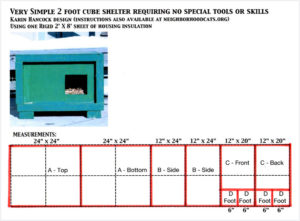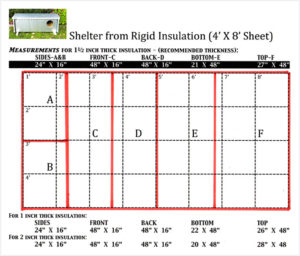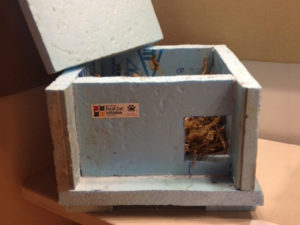Advantages:
This shelter, originally designed by Karin Hancock of Port Washington, NY, requires more assembly than the box shelters, but you don’t need special skills or tools. This elegant, economical design features a built-in overhang and is raised off the ground. The boards are inexpensive and available at hardware stores — note that they also come in an easier-to-transport 2’x2′ size. It’s also possible to get surplus boards for free from a contractor. We offer Karin’s original pattern for a 2’x2′ shelter using a single sheet of foam board (Plan A, which sleeps 2–3 cats), as well as the FCI’s adaptation that uses two boards to make a 2’x4′ shelter (Plan B, which sleeps 4–5 cats).
You’ll need:
- One 2’x8′ sheet of rigid foam housing insulation, 2″ thick preferably (for Plan B, use a 4’x8′ board or two 2’x8′ boards)
- Tube(s) of all-weather adhesive caulk (squeeze-tube or one that requires a caulk gun)
- Box cutter
- Bread knife or fine-bladed saw
- Measuring tool/straight edge (a T-square is ideal)
- Upholstery T-pins, thin long nails, or long construction screws
- Optional: self-stick floor tiles or contact paper, camouflage paint
Assembly:
- Cut and label the pieces according to the pattern. Tip: First make a shallow “guide” cut using the box cutter — this makes it easy to make a clean cut all the way through using the knife.
- Cut a 5½”x5½” door in the front panel (C).
- Glue the feet (D) to the bottom (A).
- Glue one of the sides (B) to the bottom.
- Glue the back (C) to the bottom and side. Optional: Use a couple of T-pins, nails, or screws to hold the two wall panels securely together while the glue dries. Nails or screws may be left in for extra reinforcement.
- Glue the front (C) to the bottom and side, using pins/nails/screws if desired.
- Glue the second side (B) to the bottom, front, and back, using pins/nails/screws if desired.
- Check the seams for any gaps and patch with extra caulk as needed.
- Add floor tiles or contact paper, and straw.
- Glue the top (A) on, using pins/nails/screws if desired.
Plan A

Plan B


